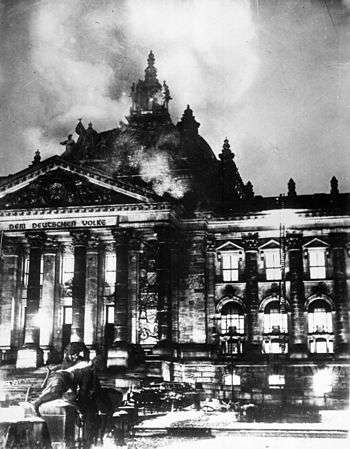Karl Ernst
| Karl Ernst | |
|---|---|
 Ernst in 1933 | |
| Born |
Berlin, Germany 1 September 1904 |
| Died |
30 June 1934 (aged 29) Berlin, Germany |
| Occupation | German military officer |

Karl Ernst (1 September 1904, Berlin – 30 June 1934, Berlin) was an SA- Gruppenführer who, in early 1933, was the SA leader in Berlin. Before joining the Nazi Party he had been a hotel bellboy and a bouncer at a gay nightclub.[1]
Reichstag fire
It has been suggested[2] that it was he who, with a small party of stormtroopers, passed through a passage from the Palace of the President of the Reichstag, and set the Reichstag building on fire on the night of February 27, 1933. There is evidence indirectly to substantiate this: Gisevius at Nuremberg implicated Goebbels in planning the fire,[3] Rudolph Diels stated[4] that Göring knew how the fire was to be started, and General Franz Halder stated[5] that he had heard Göring claim responsibility for the fire. However, according to Ian Kershaw, the consensus of nearly all historians is that Marinus van der Lubbe did set the Reichstag on fire.[6]
Night of the Long Knives
On 30 June 1934 Ernst had just married, and was in Bremen on his way to Madeira to honeymoon with his new wife.[7] SA Leader Ernst Röhm had repeatedly called for a "second revolution" that would introduce socialism into the Reich and banish the old Conservative forces of business and government.[8] Fearing the socialistic tendencies of the SA, along with Röhm's ambition to absorb the Reichswehr into the SA, conservative elements in the German Army and Kriegsmarine pressed for an elimination of SA power.[9][10] Adolf Hitler undertook a purge of the SA — an event known to history as the "Night of the Long Knives". It lasted until 2 July 1934.
Ernst was arrested in Bremerhaven together with his wife and his friend Martin Kirschbaum as he was about to get aboard a cruiser in order to travel to Madeira where he planned to spend his honeymoon. Later on he was handed over to an SS-commando unit led by Kurt Gildisch, flown back to Berlin and taken to the barracks of the Leibstandarte Adolf Hitler, where he was shot by a firing squad in the early evening of June 30. According to the official death list drawn up for internal-administrative use by the Gestapo he was one of fourteen people shot on the grounds of the Leibstandarte.[11]
References
- ↑ Shirer, William L., The Rise and Fall of the Third Reich, Simon & Schuster, 1960, p. 220.
- ↑ Shirer, William L., The Rise and Fall of the Third Reich, Simon & Schuster, 1960, p. 192.
- ↑ Hans Gisevius, Nuremberg testimony
- ↑ Nuremberg affidavit
- ↑ Franz Halder, Nuremberg testimony
- ↑ Kershaw, Ian. Hitler: Hubris pp. 456–458 & 731–732.
- ↑ Shirer, William L., The Rise and Fall of the Third Reich, Simon & Schuster, 1960, p. 221.
- ↑ Shirer, William L., The Rise and Fall of the Third Reich, Simon & Schuster, 1960, pp. 204-8, 213-17.
- ↑ Shirer, William L. The Rise and Fall of the Third Reich, Simon & Schuster, 1960, pp. 214-220.
- ↑ Wheeler-Bennett, John. The Nemesis of Power: The German Army in Politics 1918–1945, Palgrave Macmillan, 2005, 1967, p. 726.
- ↑ Federal Archive NS 23/45.